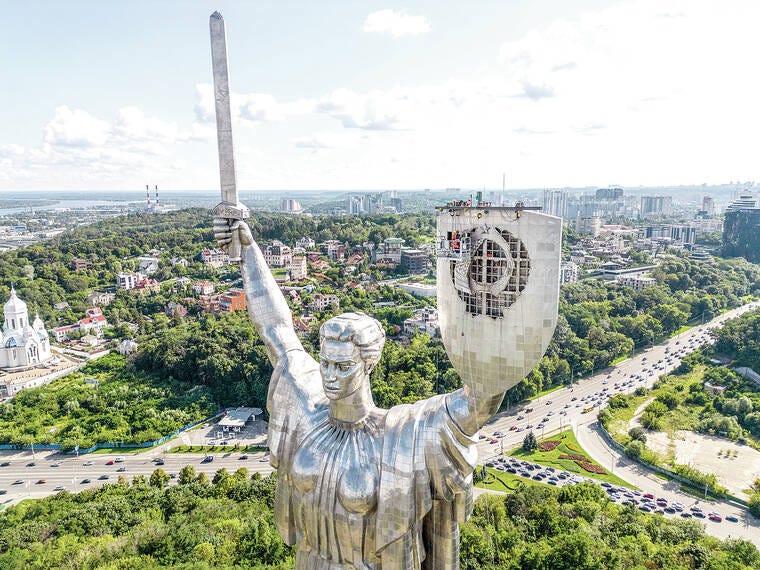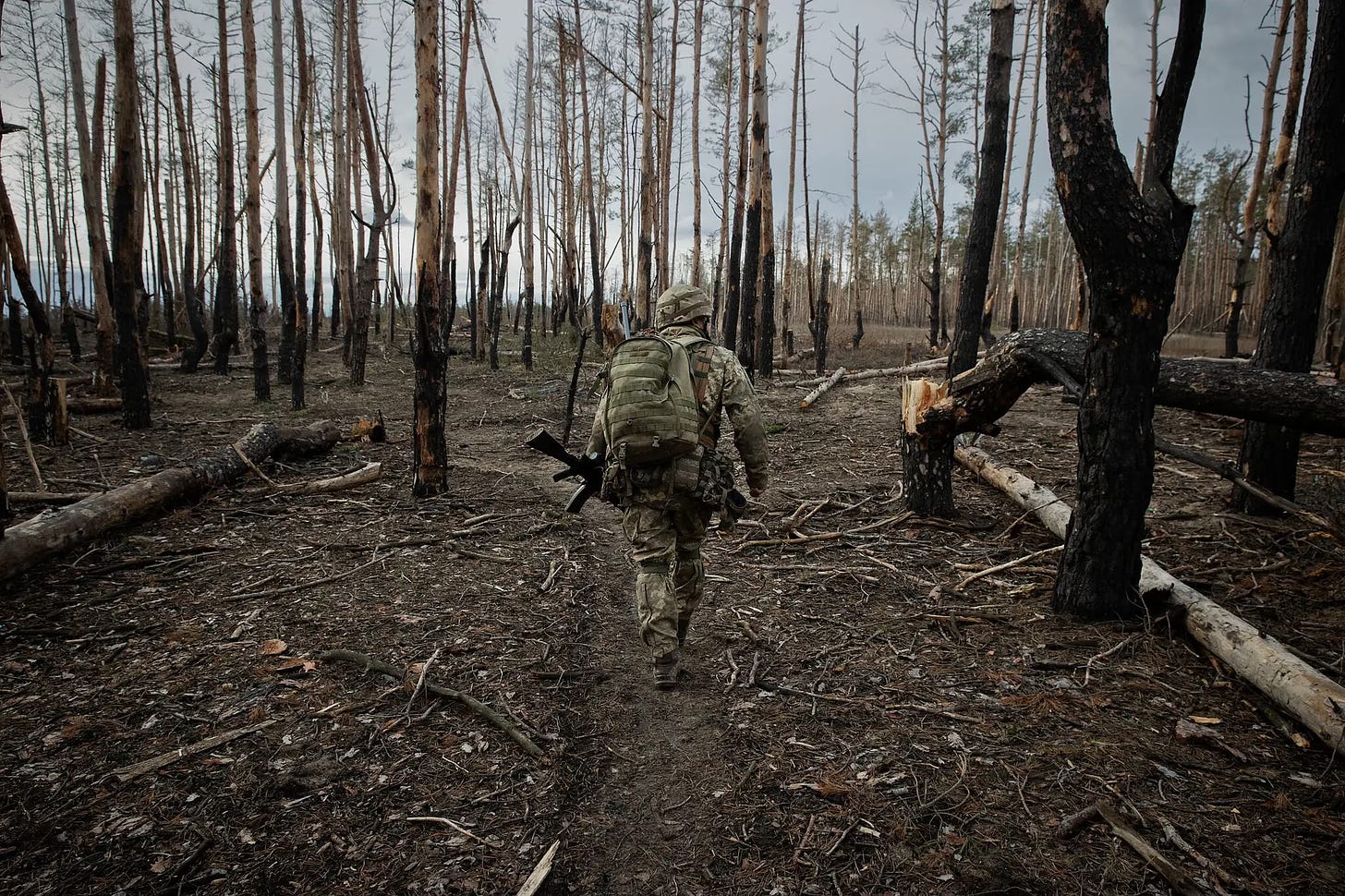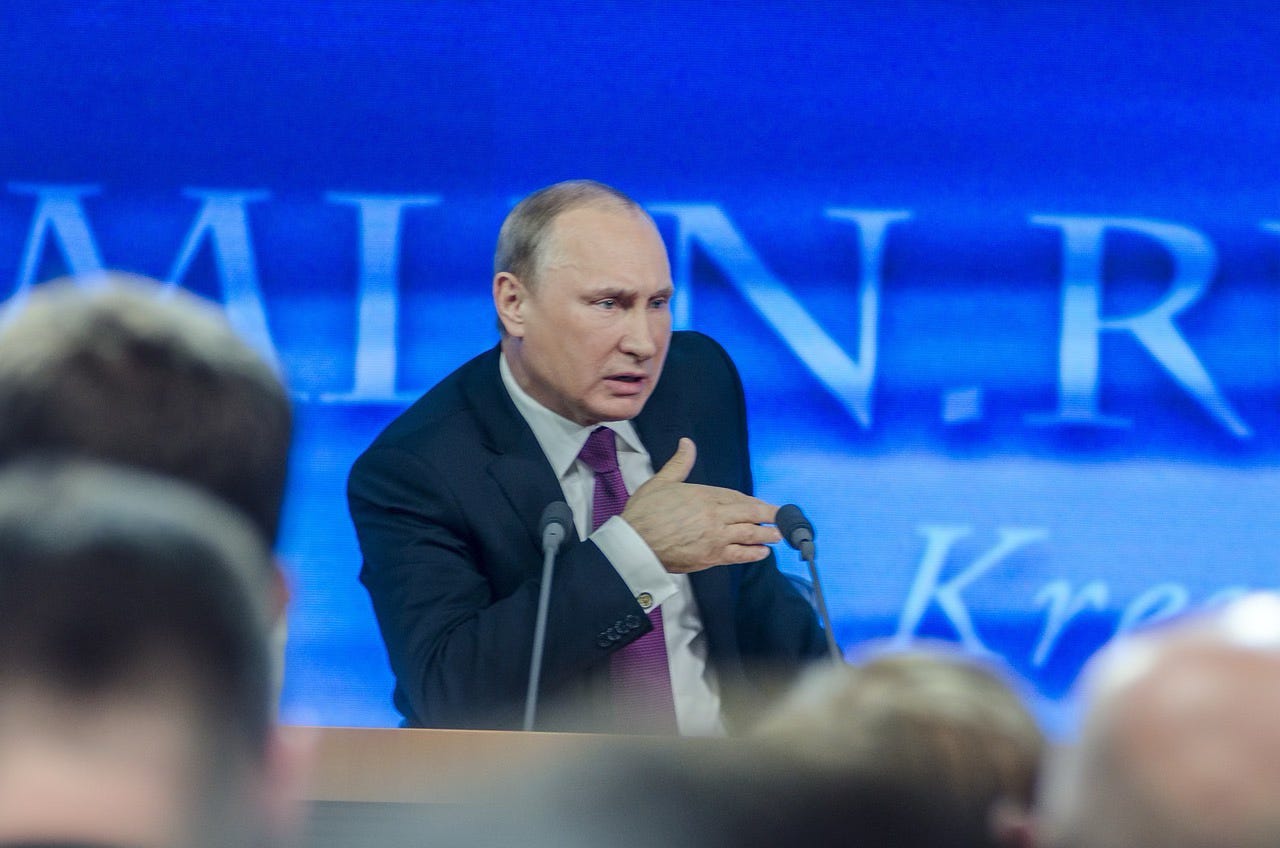By Adam Entous and Michael Schwirtz
Nestled in a dense forest, the Ukrainian military base appears abandoned and destroyed, its command center a burned-out husk, a casualty of a Russian missile barrage early in the war.
But that is above ground.
Not far away, a discreet passageway descends to a subterranean bunker where teams of Ukrainian soldiers track Russian spy satellites and eavesdrop on conversations between Russian commanders. On one screen, a red line followed the route of an explosive drone threading through Russian air defenses from a point in central Ukraine to a target in the Russian city of Rostov.
The underground bunker, built to replace the destroyed command center in the months after Russia’s invasion, is a secret nerve center of Ukraine’s military.
There is also one more secret: The base is almost fully financed, and partly equipped, by the CIA.
“One hundred and ten percent,” Gen. Serhii Dvoretskiy, a top intelligence commander, said in an interview at the base.
Now entering the third year of a war that has claimed hundreds of thousands of lives, the intelligence partnership between the United States and Ukraine is a linchpin of Ukraine’s ability to defend itself. The CIA and other U.S. intelligence agencies provide intelligence for targeted missile strikes, track Russian troop movements and help support spy networks.
But the partnership is no wartime creation, nor is Ukraine the only beneficiary.
It took root a decade ago, coming together in fits and starts under three very different U.S. presidents, pushed forward by key individuals who often took daring risks. It has transformed Ukraine, whose intelligence agencies were long seen as thoroughly compromised by Russia, into one of Washington’s most important intelligence partners against the Kremlin today.
The listening post in the Ukrainian forest is part of a CIA-supported network of spy bases constructed in the past eight years that includes 12 secret locations along the Russian border. Before the war, the Ukrainians proved themselves to the Americans by collecting intercepts that helped prove Russia’s involvement in the 2014 downing of a commercial jetliner, Malaysia Airlines Flight 17. The Ukrainians also helped the Americans go after the Russian operatives who meddled in the 2016 U.S. presidential election.
Around 2016, the CIA began training an elite Ukrainian commando force — known as Unit 2245 — which captured Russian drones and communications gear so that CIA technicians could reverse-engineer them and crack Moscow’s encryption systems. (One officer in the unit was Kyrylo Budanov, now the general leading Ukraine’s military intelligence.)
And the CIA also helped train a new generation of Ukrainian spies who operated inside Russia, across Europe, and in Cuba and other places where the Russians have a large presence.
The relationship is so ingrained that CIA officers remained at a remote location in western Ukraine when the Biden administration evacuated U.S. personnel in the weeks before Russia invaded in February 2022. During the invasion, the officers relayed critical intelligence, including where Russia was planning strikes and which weapons systems they would use.
“Without them, there would have been no way for us to resist the Russians, or to beat them,” said Ivan Bakanov, who was then head of Ukraine’s domestic intelligence agency, the SBU.
The details of this intelligence partnership, many of which are being disclosed by The New York Times for the first time, have been a closely guarded secret for a decade.
In more than 200 interviews, current and former officials in Ukraine, the United States and Europe described a partnership that nearly foundered from mutual distrust before it steadily expanded, turning Ukraine into an intelligence-gathering hub that intercepted more Russian communications than the CIA station in Kyiv, Ukraine, could initially handle. Many of the officials spoke on condition of anonymity to discuss intelligence and matters of sensitive diplomacy.
Now these intelligence networks are more important than ever, as Russia is on the offensive and Ukraine is more dependent on sabotage and long-range missile strikes that require spies far behind enemy lines. And they are increasingly at risk: If Republicans in Congress end military funding to Kyiv, the CIA may have to scale back.
To try to reassure Ukrainian leaders, William Burns, the CIA director, made a secret visit to Ukraine Thursday, his 10th visit since the invasion.
From the outset, a shared adversary — President Vladimir Putin of Russia — brought the CIA and its Ukrainian partners together. Obsessed with “losing” Ukraine to the West, Putin had regularly interfered in Ukraine’s political system, handpicking leaders he believed would keep Ukraine within Russia’s orbit, yet each time it backfired, driving protesters into the streets.
Putin has long blamed Western intelligence agencies for manipulating Kyiv and sowing anti-Russia sentiment in Ukraine.
Toward the end of 2021, according to a senior European official, Putin was weighing whether to launch his full-scale invasion when he met with the head of one of Russia’s main spy services, who told him that the CIA, together with Britain’s MI6, were controlling Ukraine and turning it into a beachhead for operations against Moscow.
But the Times investigation found that Putin and his advisers misread a critical dynamic. The CIA didn’t push its way into Ukraine. U.S. officials were often reluctant to fully engage, fearing that Ukrainian officials could not be trusted, and worrying about provoking the Kremlin.
Yet a tight circle of Ukrainian intelligence officials assiduously courted the CIA and gradually made themselves vital to the Americans. In 2015, Gen. Valeriy Kondratiuk, then Ukraine’s head of military intelligence, arrived at a meeting with the CIA’s deputy station chief and without warning handed over a stack of top-secret files.
That initial tranche contained secrets about the Russian navy’s northern fleet, including detailed information about the latest Russian nuclear submarine designs. Before long, teams of CIA officers were regularly leaving his office with backpacks full of documents.
“We understood that we needed to create the conditions of trust,” Kondratiuk said.
As the partnership deepened after 2016, the Ukrainians became impatient with what they considered Washington’s undue caution, and began staging assassinations and other lethal operations, which violated the terms the White House thought the Ukrainians had agreed to. Infuriated, officials in Washington threatened to cut off support, but they never did.
“The relationships only got stronger and stronger because both sides saw value in it, and the U.S. Embassy in Kyiv — our station there, the operation out of Ukraine — became the best source of information, signals and everything else, on Russia,” said a former senior U.S. official. “We couldn’t get enough of it.”
NO ENDGAME
After Putin launched the invasion on Feb. 24, 2022, the CIA officers at the hotel were the only U.S. government presence on the ground. Every day at the hotel, they met with their Ukrainian contacts to pass information. The old handcuffs were off, and the Biden White House authorized spy agencies to provide intelligence support for lethal operations against Russian forces on Ukrainian soil.
Often, the CIA briefings contained shockingly specific details.
On March 3, 2022 — the eighth day of the war — the CIA team gave a precise overview of Russian plans for the coming two weeks. The Russians would open a humanitarian corridor out of the besieged city of Mariupol that same day, and then open fire on the Ukrainians who used it.
The Russians planned to encircle the strategic port city of Odesa, according to the CIA, but a storm delayed the assault and the Russians never took the city. Then, on March 10, the Russians intended to bombard six Ukrainian cities, and had already entered coordinates into cruise missiles for those strikes.
The Russians also were trying to assassinate top Ukrainian officials, including Zelenskyy. In at least one case, the CIA shared intelligence with Ukraine’s domestic agency that helped disrupt a plot against the president, according to a senior Ukrainian official.
When the Russian assault on Kyiv had stalled, the CIA station chief rejoiced and told his Ukrainian counterparts that they were “punching the Russians in the face,” according to a Ukrainian officer who was in the room.
Within weeks, the CIA had returned to Kyiv, and the agency sent in scores of new officers to help the Ukrainians. A senior U.S. official said of the CIA’s sizable presence, “Are they pulling triggers? No. Are they helping with targeting? Absolutely.”
Some of the CIA officers were deployed to Ukrainian bases. They reviewed lists of potential Russian targets that the Ukrainians were preparing to strike, comparing the information that the Ukrainians had with U.S. intelligence to ensure that it was accurate.
Before the invasion, the CIA and MI6 had trained their Ukrainian counterparts on recruiting sources, and building clandestine and partisan networks. In the southern Kherson region, which was occupied by Russia in the first weeks of the war, those partisan networks sprang into action, according to Kondratiuk, assassinating local collaborators and helping Ukrainian forces target Russian positions.
In July 2022, Ukrainian spies saw Russian convoys preparing to cross a strategic bridge across the Dnieper River and notified MI6. British and U.S. intelligence officers then quickly verified the Ukrainian intelligence, using real-time satellite imagery.
At the underground bunker, Dvoretskiy said a German anti-aircraft system now defends against Russian attacks. An air-filtration system guards against chemical weapons and a dedicated power system is available, if the power grid goes down.
The question that some Ukrainian intelligence officers are now asking their U.S. counterparts — as Republicans in the House weigh whether to cut off billions of dollars in aid — is whether the CIA will abandon them. “It happened in Afghanistan before and now it’s going to happen in Ukraine,” a senior Ukrainian officer said.
Referring to Burns’ visit to Kyiv last week, a CIA official said, “We have demonstrated a clear commitment to Ukraine over many years and this visit was another strong signal that the U.S. commitment will continue.”
The CIA and the HUR have built two other secret bases to intercept Russian communications, and combined with the 12 forward operating bases, which Kondratiuk says are still operational, the HUR now collects and produces more intelligence than at any time in the war — much of which it shares with the CIA.
“You can’t get information like this anywhere — except here, and now,” Dvoretskiy said.








